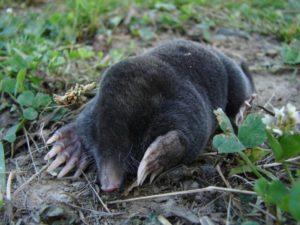Mole size: photo of the animal and its habitat
Gardeners know that the appearance of a mole on the site is a loss of crop. But the mole himself will not eat plants, he prefers more healthy and nutritious animal products. What then is its harm - let's get to know each other better.
Content
What does a mole look like (photo)
Description and characteristics of the animal
Name: Mole
Latin:MoleClass: Mammals - Mammalia
Squad: Insectivores - Eulipotyphla or Lipotyphla
Family: Mole - Talpidae
 | Habitats: | garden, forest belt, meadows and vegetable gardens |
 | Catering: | predator, rarely herbivore |
 | Description: | underground inhabitant with good hearing and scent |
A mole is a representative of the class mammals. He bears the name, which means "digger" and fully conveys his way of life. Animal of small size, from 12 to 18 cm and a maximum weight of 300 grams.
The special structure of the mole family is obvious and prominent, due to the way of life:
- the body is bar-shaped, rounded;
- the ears are modified, look like a skin roller, covered;
- the head is compact, cone-shaped;
- nose protruding, mobile, vibrissae very sensitive;
- the eyes are formed, but small, depending on the subspecies, they can be completely covered with an eyelid;
- the number of teeth varies, but they are powerful;
- the front paws seem to be turned outward with palms, on them fingers with powerful claws;
- the tail is short;
- the fur is thick and very velvety, it is quickly erased, and the mole often sheds.
Previously, mole skins were valued in industry and used to create clothing.
Distribution and habitat
Moles are distributed from the north of the taiga to the dry steppes of the south. Virtually anywhere they can find food and dig the ground. In deserts and frozen tundras, moles are not to be found. They prefer fertile soil and dislike swamps.
Although moles are excellent swimmers, they prefer edges, fields and meadows. It also settles near human habitats.
Interestingly, if necessary, moles run perfectly backwards.
Character and lifestyle
The very first and distinguishing feature is that the mole lives only underground. Of course, he will not die if he gets into the sun, but he will back into place. The whole life of a mole consists of digging passages and labyrinths. Moreover, he has an excellent organization, there are stern and running tunnels, rooms for supplies and otnorki for excess soil.
mole hole - an ingenious building. A short guide-acquaintance can convince you of this.
Moles love their home very much and return there, even if they were expelled for some reason. To the rivers for drinking, to search for and develop new territory or food, they can travel great distances.
The character of the mole can be called grumpy and absurd. He does not get along on the territory with another mole, only for the duration of mating. And here baby mole - a sweet and affectionate creature. However, as they grow, they become like their parents, develop new territories and expand housing.
The life span of the animal reaches a maximum of 6 years. They eat every 4-5 hours, after which they doze and digest.
Moles store up to 1000 worms for the winter, but they eat them correctly, starting from the end and squeezing the soil with their paws and teeth.
Mole passages are a cozy place for earthworms, which are happy to go to a warm place with a pleasant smell.
Moles are active around the clock and all year round. They are constantly in search of food to get enough or collect preparations for the winter.
If something happens to the mole, he stops marking the territory, then others will quickly move to his home.
The mole marks the territory with a special secret that stands out on the abdomen. So he determines his place of residence.
Adults are grumpy, they can bite a relative if he accidentally got into someone else's territory.
Reproduction
Moles mate on the surface.
Moreover, females later enter puberty than males. Pregnancy, depending on the type of mole, reaches from 30 days to 9 months.
In nature, their enemies are only birds of prey, which grab moles that hit the surface. In rare cases, badgers, wild boars and martens can covet them.
Representatives of the species
In total, the family has about 40 different species of animals.
Ordinary
It is standard or European. A typical representative of its species, which is familiar to many gardeners. A small rodent with a soft velvet skin and an aggressive disposition. There are a number of subspecies of this animal:
- blind;
- Caucasian;
- long-tailed;
- Siberian.
starfish
It is also called star-nosed mole, from the same mole, with unusual processes on the proboscis.
Japanese shrew
The only representative of the species, so named for its resemblance to shrews. The difference of the species is the ability to live on trees. He can arrange housing for the bench both underground and in the nest.
Mole: friend or foe
The mole has its own cuisine and eating habits. He does not eat plant foods, prefers nutritious "dishes". It destroys garden pests, just those that harm plants.
But, the whole problem is that moles dig a lot of moves. By doing this, they spoil the root system of plants, undermine plantings, dig flower beds and lawns. In large quantities, the destruction of earthworms will not bring anything good, because they loosen the soil and are useful for soil formation.
Often the activity of moles is confused with harm from a mole rat. These animals, similar in habits, are actually completely different!
How to destroy moles
A large population of moles will damage the farm. Even one animal can cause crop damage. Therefore, gardeners have picked up a number of ways that you can deal with moles.
Humanists believe that an inherently harmless animal does not need to be destroyed, it only needs to be expelled.
According to the links to the proposed articles, everyone can find a suitable one for themselves.
Conclusion
Moles seem to be useful animals, but they harm gardeners. Their endless tunnels and passages can significantly spoil the appearance of the lawn and the root system of plantings. How to deal with a mole is everyone's business.


